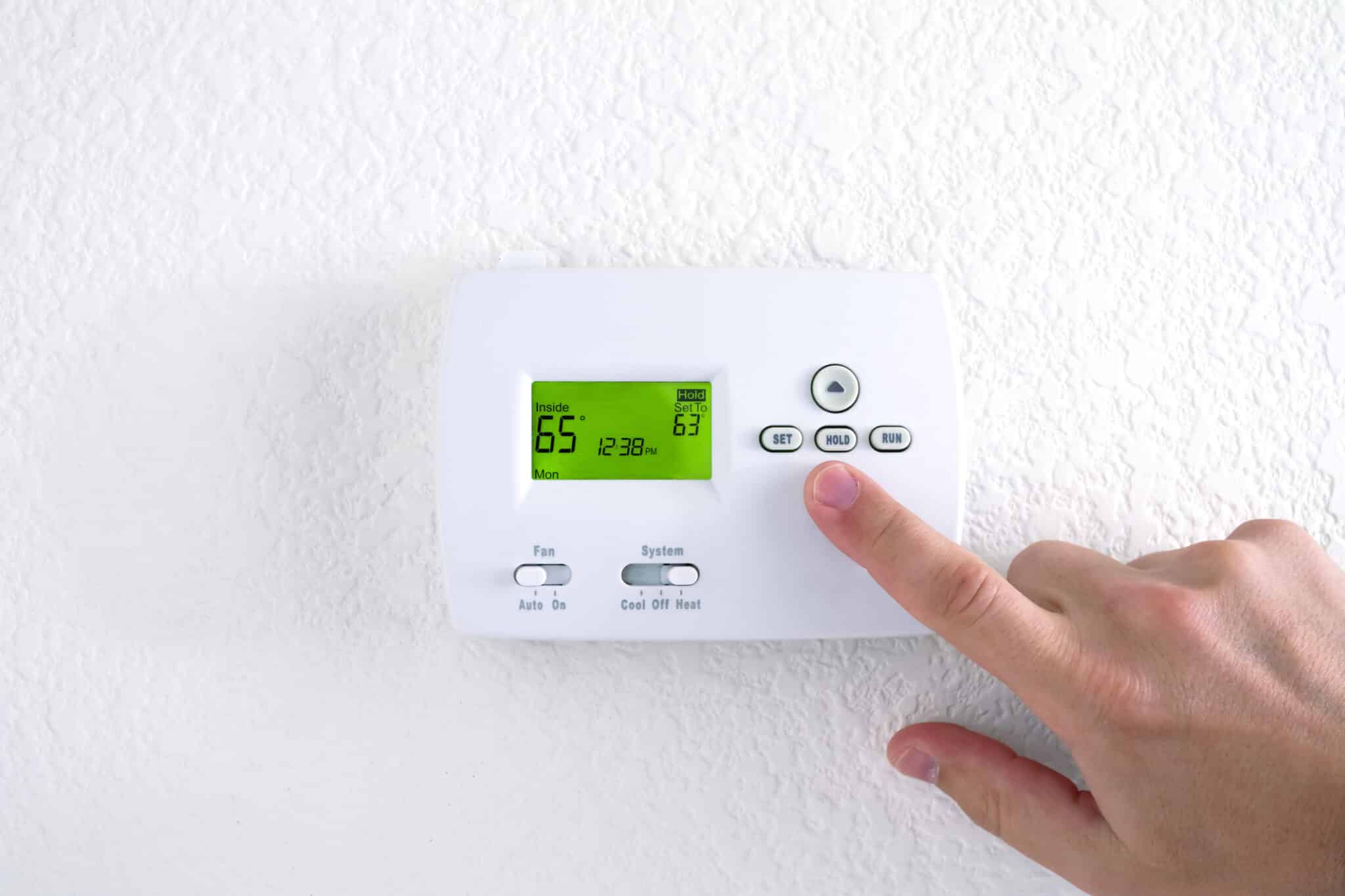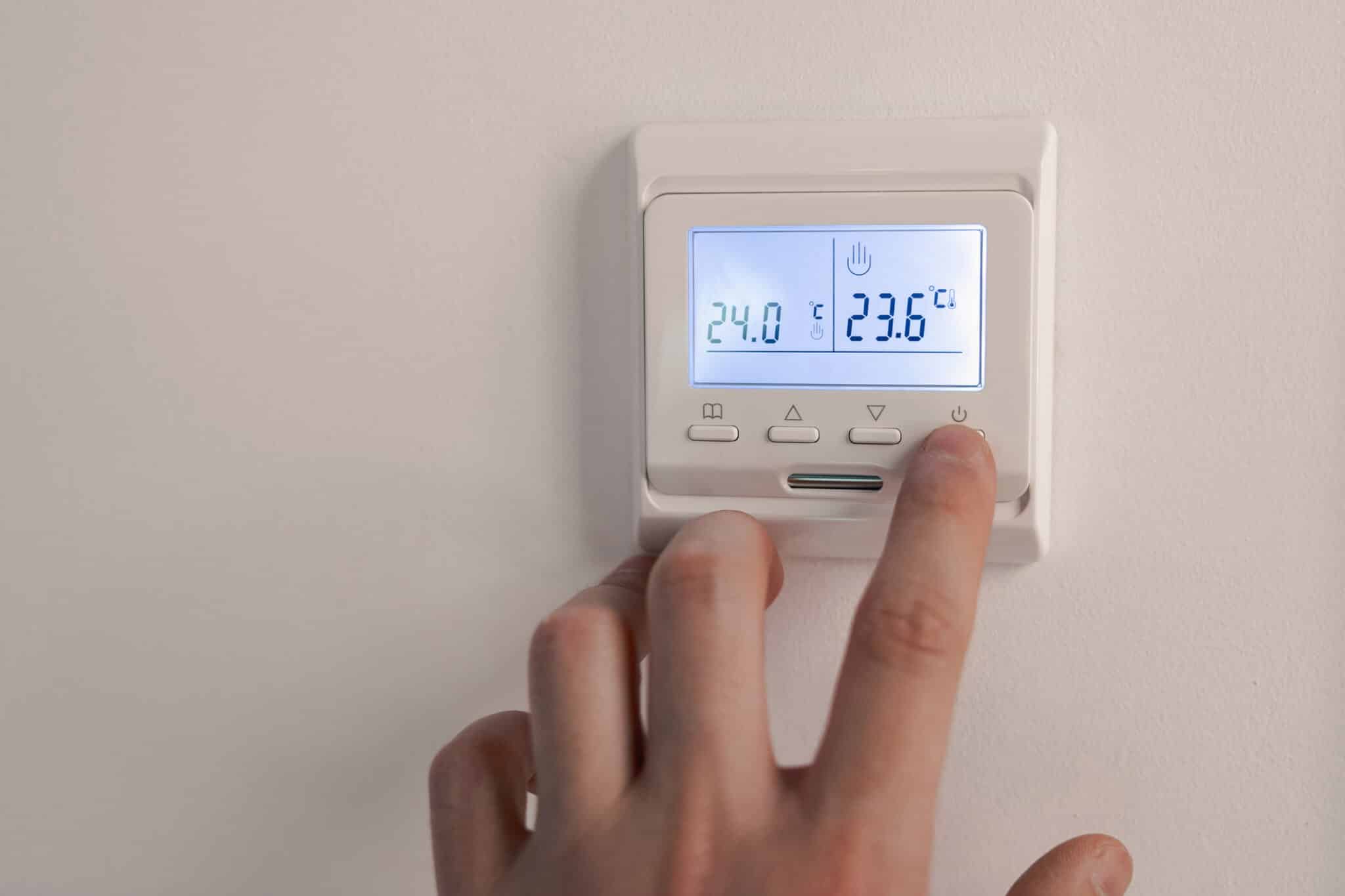If your thermostat is blinking, it’s typically trying to send you a specific message about your HVAC system’s status. The blinking may indicate anything from normal maintenance needs to potential system issues. Understanding these signals helps you respond appropriately, whether it’s a quick fix or a call for professional help. Let’s break down what a blinking thermostat usually signifies and why it’s important for keeping your home comfortable.

What Does a Blinking Thermostat Mean?
A blinking thermostat typically signals that your HVAC system needs attention. Depending on the model, this blinking can indicate anything from a routine notification to a more serious issue. For many homeowners, seeing this light can be confusing and worrisome, but understanding its purpose helps ensure peace of mind and timely action.
In Springtown, Texas, October is when temperatures start to shift, leading to increased use of heating systems. This seasonal change makes it essential to pay attention to any blinking thermostat signals. Often, the blinking means the system is in a delay mode or encountering issues like power interruptions or connection problems. It could also be warning you about HVAC malfunctions that may need immediate attention.
Recognizing these signals empowers you to assess the situation properly. Sometimes, the fix is as simple as resetting the thermostat, while other times, professional HVAC assistance may be necessary. By understanding what a blinking thermostat signifies, you can take the right steps, preventing minor issues from becoming major, costly repairs and ensuring that your home stays warm and comfortable throughout the season.
Common Reasons Your Thermostat is Blinking
Understanding the common reasons your thermostat might blink helps you determine whether a simple fix is enough or if professional help is necessary. Here are some frequent causes:
Power-Related Problems
A blinking thermostat often signals power-related issues, such as brief power interruptions or surges. These interruptions can disrupt your HVAC system, prompting the thermostat to blink while the system resets itself. This built-in safety feature ensures the system is stable before resuming operation. To check for power-related causes, inspect your circuit breakers and confirm that the power supply is consistent and reliable.
HVAC System Delays
A thermostat may blink when the HVAC system enters a delay mode. This delay is a protective measure designed to safeguard the compressor from restarting too quickly after shutting down. Typically, this delay lasts only a few minutes and indicates that the system is functioning as intended. In October, when temperature fluctuations are common in Springtown, Texas, these built-in delays are especially useful for maintaining system longevity. If the blinking stops after a short wait, it is usually not a concern.
Malfunctions in the HVAC System
A blinking thermostat may also point to more serious HVAC system malfunctions. These could include issues like frozen coils, blocked airflow, or a malfunctioning furnace. Such problems often require a professional inspection to diagnose and fix. Addressing these alerts promptly is crucial to avoid further damage or costly repairs. If the blinking persists despite basic troubleshooting, it’s time to call an expert to ensure your system remains reliable.
Power-Related Issues
A blinking thermostat often points to power-related issues impacting your HVAC system. Addressing these issues promptly can help prevent unexpected failures and ensure your home stays comfortable.
Power Surges and Outages
Power surges or brief outages are common triggers for a blinking thermostat. When these occur, the thermostat may blink as it resets to protect the HVAC system from damage when power is restored. This built-in safety mechanism ensures the system stabilizes before resuming regular operation. To determine if this is the cause, check your circuit breakers and verify that the power supply is consistent. Ensuring stability in your home’s electrical system can prevent future interruptions that might cause similar alerts.
Low Voltage Issues
A blinking thermostat can also indicate low voltage or inconsistent electrical supply. Electrical fluctuations can prevent the HVAC system from receiving the power it needs to function properly, leading to a blinking alert as a warning. Inspecting the power source and ensuring the thermostat is connected to a stable voltage source helps mitigate this issue. Addressing these electrical inconsistencies can reduce the likelihood of repeated blinking and keep your system operating smoothly.
Solutions to Try
If power issues are suspected as the reason behind a blinking thermostat, a simple reset may help. Turn the thermostat off, wait a few minutes, and then turn it back on. This allows the system to reset and resolve minor electrical interruptions. However, if the blinking persists, it could indicate a deeper electrical problem that requires professional inspection. Consulting an expert ensures any complex issues are diagnosed and repaired correctly, safeguarding your HVAC system from future damage and maintaining reliable operation.
HVAC System Malfunctions
A blinking thermostat can signal various malfunctions within your HVAC system. These issues may range from minor setbacks to significant problems that require professional intervention. Understanding what might be causing the alert allows you to act promptly and avoid costly repairs.
Frozen Coils
Frozen coils are a common reason for a blinking alert. This issue often results from low refrigerant levels or inadequate airflow. When coils freeze, the HVAC system struggles to maintain the desired temperature, prompting an alert that indicates something needs attention. This early warning helps you address the problem before it becomes more serious. Regular maintenance, such as checking refrigerant levels and ensuring proper airflow, is crucial for preventing coil freezing and keeping the system efficient.
Blocked Airflow
Blocked airflow can also trigger a blinking signal. Clogged air filters, obstructed vents, or blocked ducts restrict airflow, forcing the HVAC system to work harder. This extra strain can reduce the system’s efficiency and lifespan. To avoid this, replace air filters regularly and keep vents and ducts clear. These straightforward maintenance practices ensure smooth operation and minimize the chances of seeing a blinking alert due to airflow problems.
Furnace or System Malfunctions
Mechanical failures in the furnace or the broader HVAC system, such as faulty sensors or worn-out components, can cause blinking alerts. These issues disrupt normal operation and often require professional diagnosis and repair. Acting quickly when an alert appears due to potential malfunctions helps maintain reliable HVAC performance and prevents more extensive damage or expensive repairs.
Low Battery or Connection Problems
A blinking thermostat can often indicate simple issues like low battery power or connection problems. While these alerts may not be urgent, addressing them promptly helps ensure your HVAC system continues to run smoothly without interruptions.
Low Battery Power
One common reason for a blinking alert is low battery power. Many models have built-in blinking light features to inform homeowners when the battery level is low. This warning allows you to replace the batteries before the device stops functioning entirely. To avoid unexpected shutdowns, check battery status regularly and replace batteries every six months for consistent performance. Keeping spare batteries on hand can provide peace of mind and uninterrupted operation.
Wi-Fi or Connectivity Issues
For smart systems that rely on Wi-Fi, blinking lights can indicate connectivity issues. These problems may arise when the Wi-Fi signal weakens, the network experiences temporary interruptions, or the device disconnects from the router. To fix this, ensure your internet connection is stable and check the network settings. Restarting your router or moving it closer to the device can strengthen the signal and resolve connectivity issues effectively.
Quick Fixes
For low battery alerts, replace the batteries and reset the system to clear the warning. For connection problems, check network settings, reboot the device, or relocate the router to improve signal strength. If these solutions don’t stop the blinking, consult the user manual or contact technical support. Taking these steps ensures your HVAC system stays functional and avoids potential interruptions impacting home comfort.

Thermostat Settings and Programming Errors
A blinking thermostat may signal problems related to its settings or programming. These errors can be simple to resolve but may disrupt your HVAC system’s performance if overlooked. Knowing how to identify and fix these issues ensures your system runs efficiently.
Incorrect Settings
A common cause of a blinking thermostat is incorrect settings. For example, if the thermostat is set to cooling when heating is needed, it may start blinking to indicate the discrepancy. This alert means the system isn’t functioning as intended and requires adjustment. Reviewing the mode and temperature settings to align with your seasonal needs often solves this issue. This step is especially important in October, as temperatures in Springtown, Texas, start to drop, and heating systems become more necessary.
Programming Conflicts
Programming conflicts are another potential reason for a blinking thermostat. These conflicts may occur when there are overlapping schedules or errors in the programmed settings, causing the HVAC system to struggle to respond properly. Checking the programmed schedule and ensuring there are no conflicting commands can often resolve this issue. Adjusting the thermostat’s programming to match the time of year and expected temperatures helps maintain consistent performance.
Resetting and Basic Troubleshooting
Resetting your thermostat can often correct minor programming or setting issues. Most thermostats include a reset function, accessible either through a menu or by pressing a combination of buttons. If resetting does not stop the blinking, referring to the user manual or contacting technical support may be needed for further assistance. Regularly updating settings to match the current season helps prevent future programming problems.
When to Call a Professional
While many blinking thermostat issues can be resolved with simple troubleshooting, some problems require professional attention. Knowing when to call an HVAC expert ensures your system stays in top condition and prevents potential damage.
Persistent Blinking After Troubleshooting
If your thermostat continues to blink after you’ve tried resetting it, checking the settings, and addressing any power or connectivity issues, it may signal a more significant problem. Persistent blinking can indicate an underlying mechanical or electrical malfunction within the HVAC system. In these cases, calling a professional ensures an accurate diagnosis and prevents further complications.
HVAC System Failures
A blinking thermostat might indicate a malfunction within the HVAC system itself, such as a faulty compressor, damaged sensors, or broken components. These issues typically require specialized tools and expertise to identify and repair effectively. If your heating or cooling system is not maintaining the desired temperature or is shutting down unexpectedly, a professional should inspect it to prevent additional damage or higher repair costs.
Seasonal Maintenance Needs
October in Springtown, Texas, marks the start of cooler weather, which puts more demand on heating systems. A blinking thermostat may be a reminder that seasonal maintenance is due. Regular inspections and maintenance by an HVAC professional ensure the system runs efficiently during peak usage months. This proactive approach reduces the likelihood of sudden breakdowns and extends the system’s lifespan.
Calling a trusted HVAC service like Pro Heat & Air for comprehensive evaluations and repairs provides peace of mind and keeps your home comfortable.
Preventative Measures to Avoid a Blinking Thermostat
Preventative maintenance is key to avoiding the frustration of a blinking thermostat. Simple, proactive steps can keep your HVAC system running efficiently and prevent minor issues from becoming major problems.
Regular Battery Checks
One of the simplest ways to prevent a blinking thermostat is by checking and replacing the batteries regularly. Low battery power is a common trigger for blinking alerts. Setting a reminder to check and replace batteries every six months ensures the thermostat stays powered and functional, reducing unexpected disruptions.
Seasonal Maintenance
Scheduling regular HVAC maintenance, particularly before the start of peak heating or cooling seasons, helps prevent many issues that could lead to a blinking thermostat. In Springtown, Texas, October is an ideal time for a seasonal check-up, as it precedes the colder months when heating systems are used more frequently. A professional inspection can identify worn-out parts, airflow obstructions, or low refrigerant levels and address them before they cause bigger problems.
Clean and Replace Filters
Dirty or clogged air filters can lead to blocked airflow, which strains the HVAC system and may cause the thermostat to blink. Checking and replacing air filters every 1-3 months, depending on usage and manufacturer recommendations, helps maintain optimal system performance and prevents unnecessary strain.
Keep an Eye on Settings
Ensuring your thermostat is programmed correctly for the season is essential. Review the schedule and settings periodically to prevent conflicts that could trigger blinking alerts. Adjusting settings to match the current weather conditions in Springtown helps keep your system running smoothly and avoids unexpected alerts.
Implementing these simple preventative measures helps maintain the efficiency of your HVAC system, prolongs its lifespan, and minimizes the chances of a blinking thermostat disrupting your comfort.
FAQ About Why is my Thermostat Blinking
-
Why is my thermostat blinking when the system is off?
A thermostat may blink even when the system is off due to a delay mode or power-related issue. Delay modes are designed to protect the HVAC system’s compressor after recent use, preventing it from restarting too soon. Power interruptions or connectivity problems can also trigger a blinking alert. If the blinking continues, try resetting the thermostat or checking for electrical issues to prevent further disruptions.
-
Can a blinking signal fix itself?
In some cases, a blinking signal may stop on its own once the underlying issue is resolved, such as when a system delay completes or after a brief power surge. However, if the blinking persists for a prolonged period, it might indicate a deeper issue that needs attention. Investigating the cause ensures your HVAC system stays reliable and efficient.
-
How long should I wait before resetting my thermostat?
It’s generally safe to wait a few minutes after noticing a blinking thermostat before attempting a reset. This short waiting period allows the system to complete any built-in safety delays. If the blinking does not stop, turn the thermostat off, wait for a few minutes, and turn it back on to clear the warning.
-
Is it safe to ignore a blinking signal?
Ignoring a blinking signal can lead to more serious problems if it indicates a significant issue. While some alerts are minor, such as battery replacement or delay mode, others could signal malfunctions that require professional attention. Addressing the cause promptly helps maintain system performance and prevents costly repairs.
-
What maintenance can I do to prevent future issues?
Preventative maintenance includes checking and replacing thermostat batteries regularly, scheduling seasonal HVAC inspections, cleaning or replacing air filters, and reviewing thermostat settings. These actions help prevent a blinking thermostat, ensure consistent HVAC performance, and extend the system’s lifespan.








